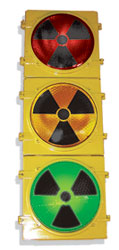The development and construction of the world's first nuclear powerplants starting in the mid-1950s was thought to be the threshold of an age where the generation of electricity would be "too cheap to meter." That of course proved to be nonsense, but the world, it seems, is eager to place some new bets on nukes. They will be carefully considered ones, based on the positive experience of many powerplants that have been quietly churning out vast amounts of electricity over the past 50 years, and mindful of the ecological and financial disasters at the Chernobyl, Three Mile Island and Shoreham nuke plants.
 |
Faster, cheaper, better are the marching orders for the designers and builders of the third generation of powerplants. And there is a growing, but still gentle, push from some environmentalists who feel that baseload nuclear generating stations will help the world curtail greenhouse gasses and other pollution from burning fossil fuels.
It seems that the industrial revolution may finally be reaching nuclear powerplants. Most of the second generation of plants now operating throughout the world have custom designs. That made licensing problematic and heightened the opportunity for design and construction defects. It also made operator training far more difficult, tended to staunch the flow of information among utilities and confused public expectations.
The new generation of plants is expected to be far more efficient to build. With major manufacturers standardizing their reactor design, costs can be lowered, just as Henry Ford discovered when he started mass producing automobiles 100 years ago. While a baseload nuke plant is not a Tin Lizzie, the economic principals remain the same. Westinghouse expects its first AP1000 reactor to cost $1.4 billion and then fall to $1 billion after volume production.
Aside from economics, the biggest hurdle for the nuclear power industry in the U.S. and elsewhere is to win over the hearts and minds of the public. The 820-MW Shoreham plant on Long Island was the last and arguably the most sophisticated powerplant in the U.S. In design and construction for 25 years, its cost ballooned 85 times the original estimate to $5.6 billion by the time it was completed in 1984. Fierce public opposition and an arrogant owner caused the plant to be closed forever in 1989 after only three days on the grid in testing. That case study must be mandatory reading for nuclear energy advocates.
The tentative green light for nuclear power is glowing brighter, but there is caution. Nuclear is but one component of what should be a comprehensive, environment-sensitive national energy program. Interest also is growing in wind, wave, solar and geothermal applications. Together, the electric meter and air may look a little brighter, but it won't be a free ride for anyone.

Post a comment to this article
Report Abusive Comment